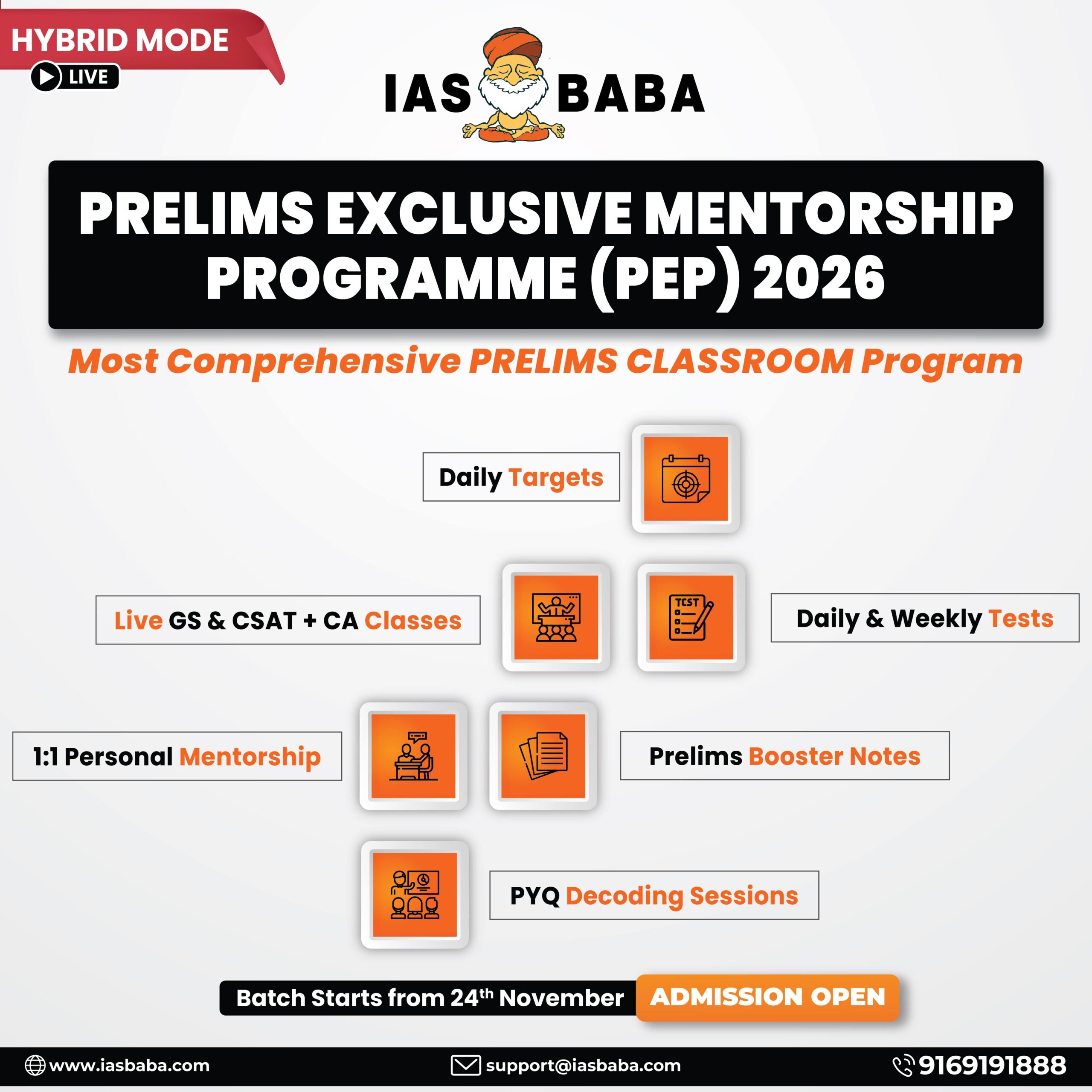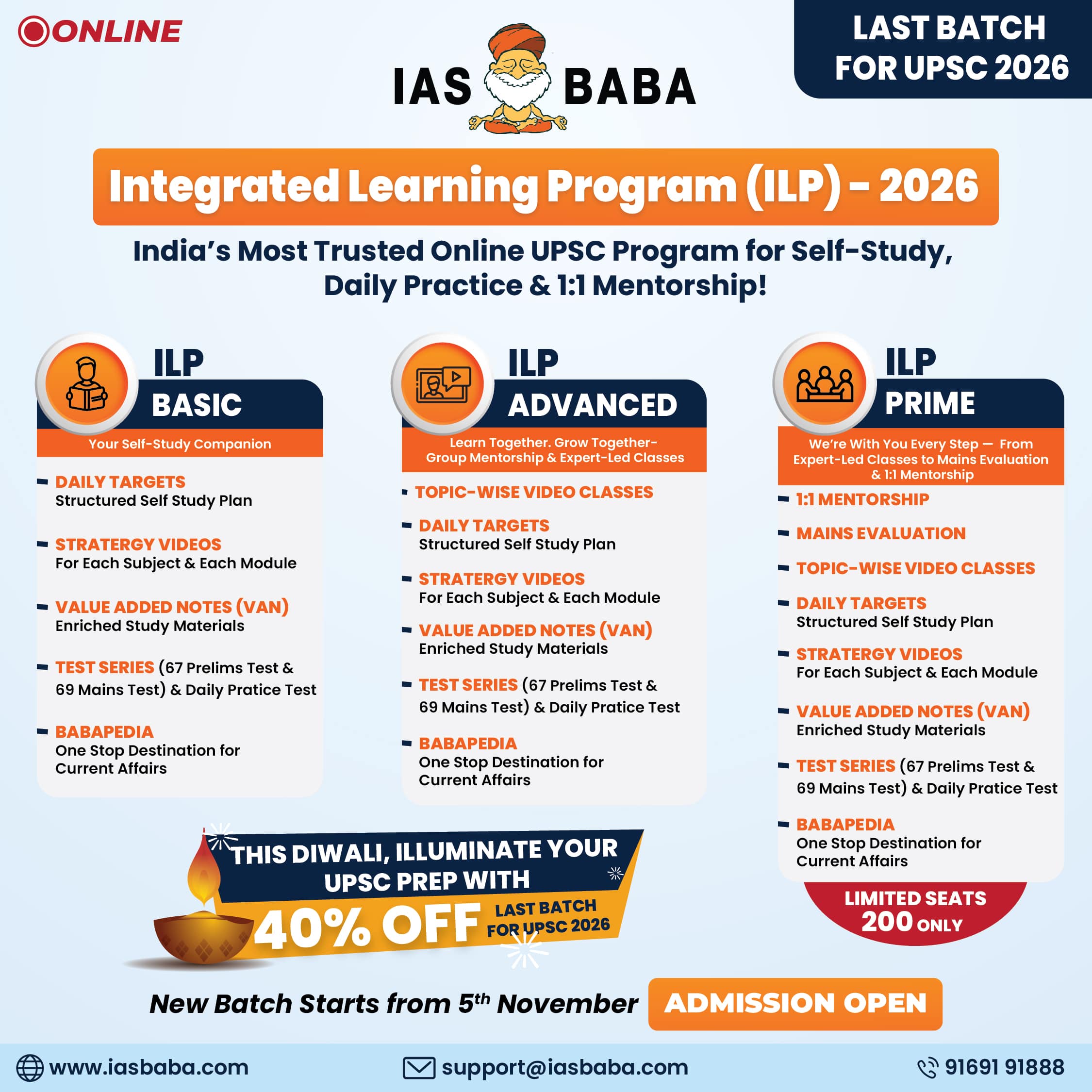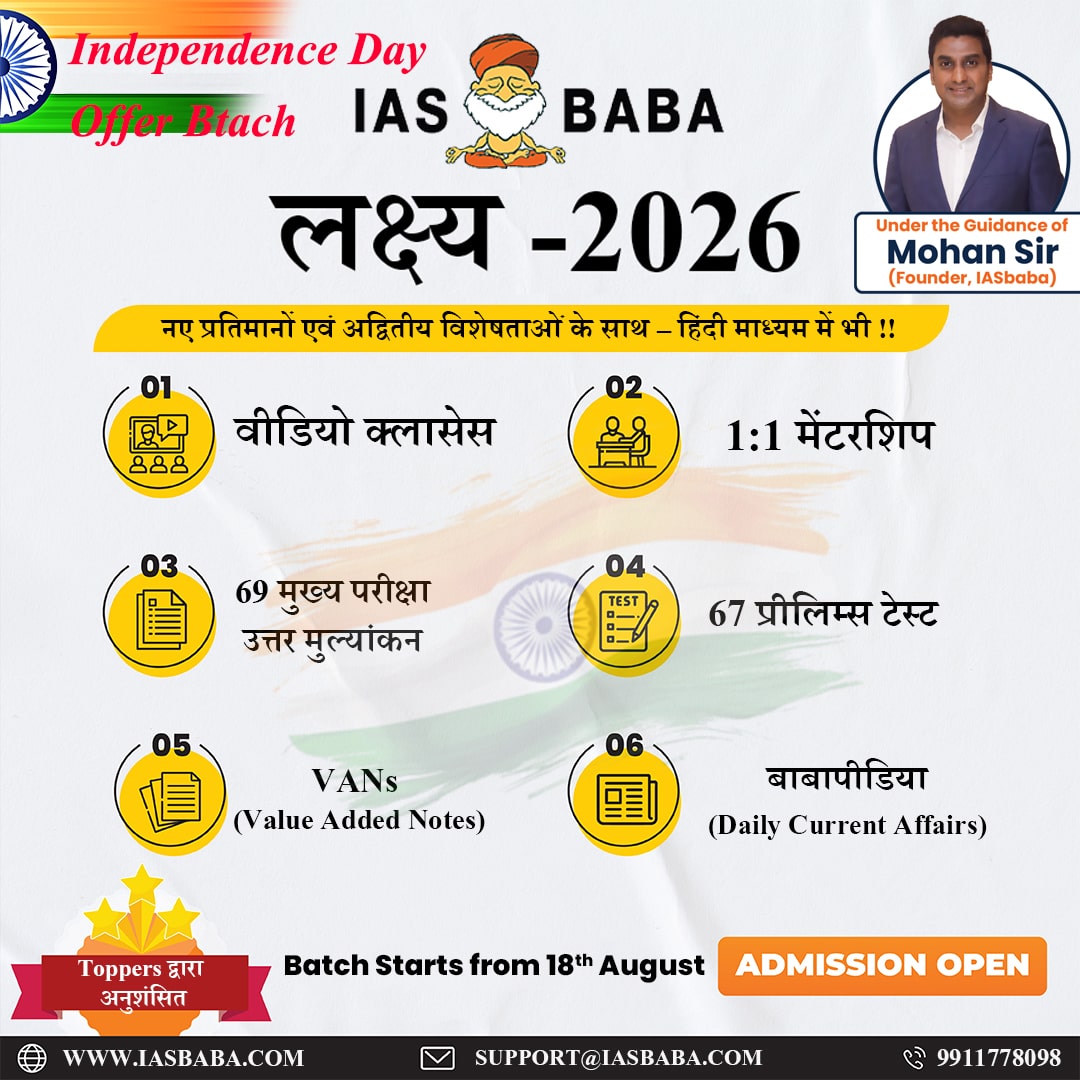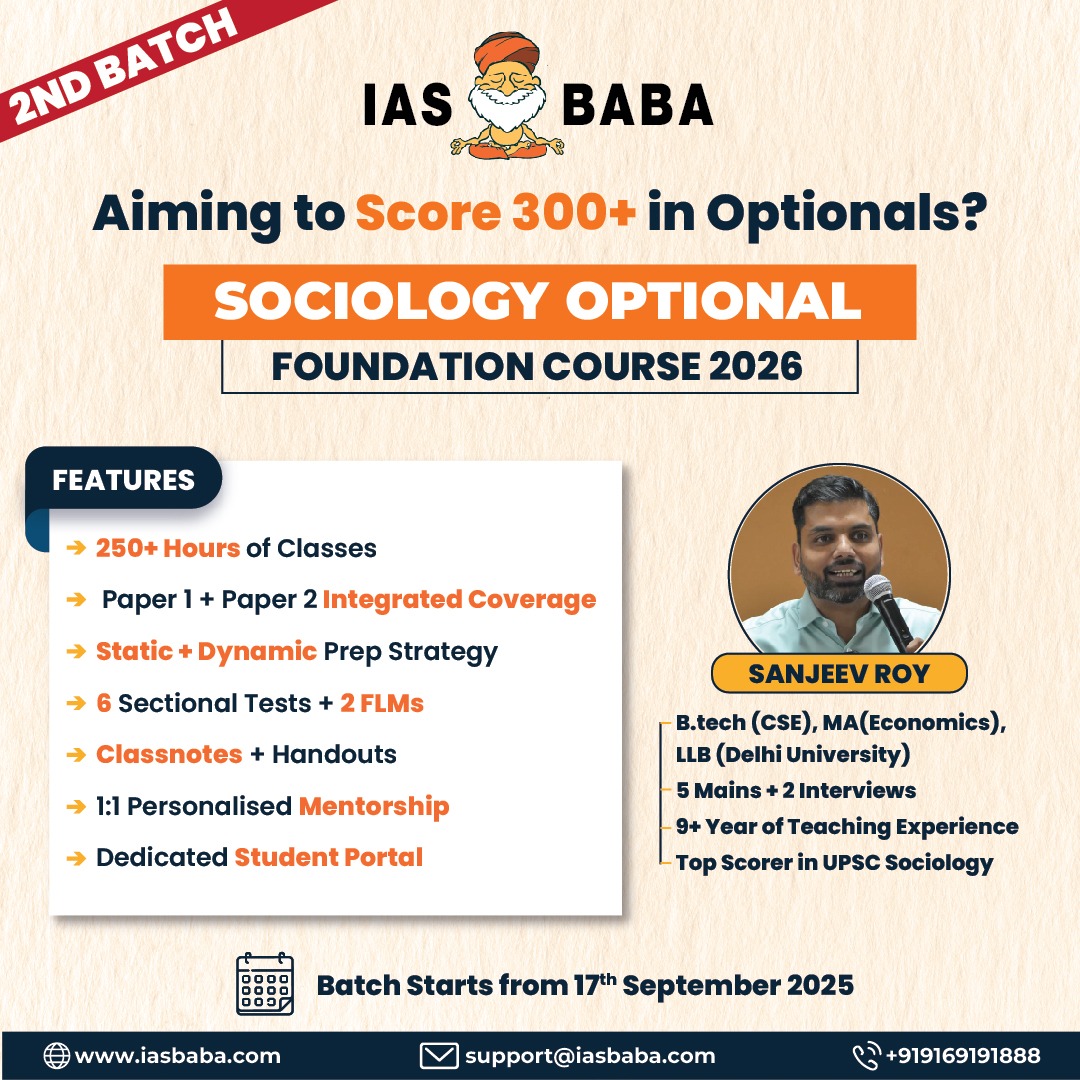IASbaba's Daily Current Affairs Analysis
Archives
(PRELIMS Focus)
Category: POLITY
Context: An Air India Boeing 787-8 Dreamliner, en route from Ahmedabad to London, crashed shortly after takeoff on June 12, 2025, killing 241 out of 242 peoples on board
Decoding Context:
Casualties and Survivors
- Total onboard: 242 (230 passengers, 2 pilots, 10 crew)
- Fatalities: 241
- Sole survivor: A British national of Indian origin (Seat 11A)
- Passenger nationalities: 169 Indians, 53 British, 7 Portuguese, 1 Canadian
- Additional victims: Residents in the crash zone feared dead or injured
Crash Details
- Took off at 1:38 PM IST
- Issued a “mayday” distress call moments after take-off
- Lost contact and crashed within minutes, followed by a large explosion
- Witnesses saw it flying abnormally low before impact
Response and Investigation
- PM Modi and the Civil Aviation Minister ordered rescue operations and suspended airport activity
- DGCA will lead the investigation with Boeing and international assistance
- Support teams and helplines set up for affected families
Notable Casualties
- Former Gujarat CM Vijay Rupani was among the passengers and is presumed dead
Learning Corner:
Organizations That Handle Airplane Accidents in India
India has a structured aviation safety framework involving multiple agencies that oversee investigation, regulation, and response to aircraft accidents. Here are the key organizations:
- Directorate General of Civil Aviation (DGCA)
- Role: Regulatory body for civil aviation in India.
- Functions:
- Ensures air safety standards.
- Grants licenses to pilots, engineers, and airlines.
- Monitors aircraft operations and airworthiness.
- In Accidents:
- Supervises initial response and coordinates with investigators.
- Ensures airline compliance with post-crash protocols.
- Aircraft Accident Investigation Bureau (AAIB)
- Role: Primary agency for investigating aircraft accidents and serious incidents.
- Established: 2011 under the Ministry of Civil Aviation (MoCA), following ICAO guidelines.
- Functions:
- Conducts independent investigations.
- Determines causes and contributing factors.
- Recommends safety measures to prevent recurrence.
- Legal Backing: Works under Aircraft (Investigation of Accidents and Incidents) Rules, 2017.
- Ministry of Civil Aviation (MoCA)
- Role: Parent ministry overseeing DGCA and AAIB.
- Functions:
- Approves aviation safety policies.
- Coordinates with other ministries (Home, Defense) during major accidents.
- Provides high-level oversight of investigations and compensation issues.
- Airports Authority of India (AAI)
- Role: Manages airport infrastructure and air traffic services.
- Functions in Accidents:
- Supports rescue and firefighting (ARFF) at airports.
- Assists in emergency coordination and communications.
- National Disaster Response Force (NDRF) & Local Administration
- Role: Provides emergency response, rescue, and recovery.
- Functions:
- Assists in evacuating survivors and retrieving bodies.
- Handles hazardous materials if involved in the crash.
Source : THE HINDU
Category: INTERNATIONAL
Context: India ranked 131st out of 148 countries in the Global Gender Gap Index 2025, slipping two spots from its 2024 rank (129th)
Key Highlights:
- Political Empowerment:
- Dropped by 0.6 points.
- Women’s representation in Parliament fell from 14.7% to 13.8%.
- Ministerial positions held by women declined from 6.5% to 5.6%.
- Economic Participation:
- Slight improvement to 40.7%.
- Women estimated earned income rose to 29.9%.
- Labour force participation parity remained at 45.9%.
- India remains in the bottom five globally for this pillar.
- Education and Health:
- Educational parity reached 97.1%.
- Health and survival scores improved slightly, aided by better sex ratio at birth.
- Regional Comparison:
- Ranked below Bangladesh (24), Bhutan (119), Nepal (125), and Sri Lanka (130).
- Ahead only of Maldives and Pakistan in South Asia.
- Global Overview:
- The global gender gap is 68.8% closed.
- At the current pace, it will take over 120 years to achieve global gender parity.
- India remains among the bottom 20 countries worldwide.
Learning Corner:
Note on Global Gender Gap Index
The Global Gender Gap Index is an annual report published by the World Economic Forum (WEF) that measures gender-based disparities across countries. First launched in 2006, the index evaluates the progress of nations toward gender parity using a standardized framework.
Key Features:
- Published by: World Economic Forum (WEF)
- Latest Edition: Global Gender Gap Report 2025
- Coverage: 148 countries (in 2025 edition)
Core Dimensions Measured:
- Economic Participation and Opportunity
- Includes wage equality, labour force participation, and advancement to leadership roles.
- Educational Attainment
- Covers literacy rates and enrolment in primary to tertiary education.
- Health and Survival
- Considers sex ratio at birth and life expectancy.
- Political Empowerment
- Measures representation in Parliament and ministerial positions.
Scoring:
- Score Range: 0 to 1
- A score of 1 indicates full gender parity.
- A score closer to 0 indicates high inequality.
Significance:
- Tracks gender gaps, not absolute levels of development.
- Helps policymakers identify areas needing intervention.
- Benchmarks progress across time and regions.
Source: THE HINDU
Category: INTERNATIONAL
Context : The International Atomic Energy Agency (IAEA) Board of Governors passed a resolution formally censuring Iran for failing to meet its nuclear obligations—the first such action in 20 years
Decoding Context:
Key Reasons for the Censure
- Iran has repeatedly failed to cooperate fully since 2019 regarding undeclared nuclear materials and sites.
- It has not provided credible explanations for uranium traces found at undisclosed locations.
- These actions violate Iran’s Safeguards Agreement under the Nuclear Non-Proliferation Treaty (NPT).
Implications
- The censure raises the possibility of Iran being referred to the UN Security Council, which could lead to renewed international sanctions.
- It has intensified geopolitical tensions, with concerns over potential Israeli military action.
Iran’s Response
- Iran rejected the resolution, calling it politically motivated.
- Announced plans to build a new uranium enrichment facility and install sixth-generation centrifuges at Fordow.
- Warned of additional retaliatory steps, including reconsidering its NPT membership.
Learning Corner:
International Atomic Energy Agency (IAEA)
- Established: 1957, under the UN.
- Headquarters: Vienna, Austria.
- Mandate: Promotes peaceful use of nuclear energy, prevents nuclear weapons proliferation.
- Functions:
- Conducts nuclear inspections.
- Ensures compliance with Safeguards Agreements.
- Assists in nuclear safety, science, and technology.
- Reports to: UN General Assembly and Security Council.
Nuclear Non-Proliferation Treaty (NPT)
- Came into force: 1970.
- Members: 191 countries (India, Pakistan, Israel are non-signatories).
- Objectives:
- Non-Proliferation: Prevent spread of nuclear weapons.
- Disarmament: Promote disarmament efforts.
- Peaceful Use: Allow access to nuclear energy for civilian use under safeguards.
- Safeguards Agreement: Signatory states must allow IAEA inspections of nuclear facilities.
JCPOA (Joint Comprehensive Plan of Action)
The Joint Comprehensive Plan of Action (JCPOA) is a nuclear agreement signed in 2015 between Iran and the P5+1 group of world powers—the United States, United Kingdom, France, Russia, China, and Germany—along with the European Union (EU).
Objective:
The primary aim of the JCPOA was to prevent Iran from developing nuclear weapons while allowing it to pursue peaceful nuclear energy, in exchange for relief from economic sanctions.
Key Provisions:
- Iran agreed to limit its uranium enrichment to 3.67% purity and reduce its centrifuge count significantly.
- It also agreed to cut its stockpile of enriched uranium and redesign its Arak heavy-water reactor.
- The International Atomic Energy Agency (IAEA) was tasked with monitoring and verifying Iran’s compliance.
- In return, the US and EU agreed to lift nuclear-related economic sanctions.
Developments:
- In 2018, the United States unilaterally withdrew from the deal under President Donald Trump and reimposed sanctions on Iran.
- Iran responded by gradually reducing its commitments, including increasing enrichment levels.
- Recent diplomatic efforts have been made to revive the deal, but talks have faced setbacks due to geopolitical tensions and Iran’s increasing nuclear activities.
Significance:
The JCPOA is seen as a cornerstone of global non-proliferation efforts and a test case for multilateral diplomacy. Its fate continues to impact regional security in West Asia and global nuclear governance.
Source : THE HINDU
Category: ECONOMICS
Category: ECONOMICS
Context : Consumer Price Index (CPI) for May 2025 is released by MoSPI
Decoding Context
CPI Inflation: May 2025 (Base Year: 2012 = 100)
Headline Retail Inflation (Year-on-Year)
- Combined: 2.82% — lowest since Feb 2019
- Rural: 2.59%
- Urban: 3.07%
- Previous Month (April 2025): 3.16% (Combined)
- Same Month Last Year (May 2024): 4.80% (Combined)
Consumer Food Price Index (CFPI) Inflation
- Combined: 0.99%
- Rural: 0.95%
- Urban: 0.96%
- April 2025: 1.78% (Combined)
- May 2024: 8.69% (Combined)
Key Drivers of Decline
- Vegetables: -13.7%
- Pulses: -8.22%
- Cereals, fruits, sugar, eggs, and household goods also showed moderation.
- A favorable base effect contributed significantly.
Category Highlights
- Fuel & Light: 2.78%
- Housing (Urban): 3.16%
- Education: 4.12%
Policy & Outlook
- The sharp fall gives the RBI policy space for possible future rate cuts (current repo rate: 5.5%).
- Outlook optimistic, supported by good monsoon projections and subdued global commodity prices.
Learning Corner:
Note on Different Inflation Indexes in India
- Consumer Price Index (CPI)
- Measures: Retail inflation faced by consumers.
- Base Year: 2012.
- Published by: National Statistical Office (NSO), Ministry of Statistics and Programme Implementation (MoSPI).
- Types:
- CPI-Combined (CPI-C) – All-India index (used for monetary policy).
- CPI-Rural
- CPI-Urban
- CPI Components: Food & beverages, housing, clothing, fuel & light, etc.
- Used by: RBI for inflation targeting under the Monetary Policy Framework.
- Wholesale Price Index (WPI)
- Measures: Price changes at the wholesale level (i.e., before retail).
- Base Year: 2011–12.
- Published by: Office of the Economic Adviser, Ministry of Commerce and Industry.
- Components:
- Primary articles (e.g., food, minerals)
- Fuel and power
- Manufactured products
- Significance: Indicates trends in producer prices and supply-chain inflation.
- GDP Deflator
- Measures: The ratio of Nominal GDP to Real GDP, capturing overall inflation in the economy.
- Published by: Central Statistical Office (CSO).
- Broadest measure of inflation, covering all goods and services in GDP.
- Used in: Economic analysis and forecasting.
- Core Inflation
- Measures: Underlying inflation trend by excluding volatile items like food and fuel.
- Not an official index but widely tracked by economists and the RBI.
- Purpose: Helps assess long-term inflationary trends and monetary policy stance.
Summary Table:
| Index | Measures | Published By | Base Year | Main Use |
|---|---|---|---|---|
| CPI | Retail prices | NSO (MoSPI) | 2012 | RBI policy, cost of living |
| WPI | Wholesale prices | Ministry of Commerce | 2011–12 | Producer trends, trade |
| GDP Deflator | Overall inflation in GDP | CSO | Varies | Economic analysis |
| Core Inflation | Stable inflation trend | Derived (not official) | — | Policy formulation |
Source: PIB
Category: POLITY
Context : The Cabinet Committee on Economic Affairs has approved two major multitracking (doubling) projects in Jharkhand, Karnataka, and Andhra Pradesh, adding approximately 318 km to the railway network with a total investment of ₹6,405 crore
Decoding Context:
Project Highlights
- Koderma–Barkakana Doubling (133 km, Jharkhand):
- Covers Koderma, Chatra, Hazaribagh, and Ramgarh districts.
- Improves coal transport and connects Patna and Ranchi via the shortest route.
- Benefits 938 villages and 1.5 million people.
- Expected freight capacity: +30.4 million tonnes/year.
- Ballari–Chikjajur Doubling (185 km, Karnataka & Andhra Pradesh):
- Covers Ballari and Chitradurga (Karnataka), and Anantapur (Andhra Pradesh).
- Benefits 470 villages and 1.3 million people.
Broader Benefits
- Connectivity Boost: Total impact on 1,408 villages and 2.8 million people.
- Freight Efficiency: Total expected freight increase of 49 million tonnes/year.
- Operational Gains: Reduced congestion and improved reliability for passenger and freight services.
- Environmental Impact: Saves 520 million litres of fuel and reduces 2,640 million kg of CO₂ emissions annually—equivalent to planting 110 million trees.
- Strategic Vision: Part of the PM-Gati Shakti Master Plan to enhance logistics, employment, and regional development.
Learning Corner:
Note on the Cabinet Committee on Economic Affairs (CCEA)
The Cabinet Committee on Economic Affairs (CCEA) is one of the most important cabinet committees in the Indian government. It plays a key role in formulating and approving economic policies and decisions that impact the nation’s economy.
Key Features:
- Established Under: Allocation of Business Rules, 1961.
- Chairperson: Prime Minister of India.
- Members: Selected Cabinet Ministers (e.g., Finance, Home, Commerce, Railways, Agriculture, etc.).
Functions of CCEA:
- Policy Approval:
- Approves major economic policies and schemes relating to agriculture, industry, energy, infrastructure, and public sector undertakings.
- Investment Proposals:
- Clears high-value investment projects above a specified financial limit (e.g., ₹1,000 crore and above).
- Disinvestment:
- Responsible for decisions on disinvestment of central public sector enterprises.
- Price Controls & Subsidies:
- Decides on pricing policies of essential commodities like sugar, fertilizers, etc.
- FIPB/FDI Cases:
- Earlier used to approve FDI proposals recommended by the now-abolished Foreign Investment Promotion Board (FIPB).
Importance:
- Ensures fast-track approval of critical economic projects.
- Supports inter-ministerial coordination on large-scale economic matters.
- Plays a vital role in driving the government’s economic reform agenda.
Source: PIB
(MAINS Focus)
Introduction (Context)
India’s pursuit of becoming a Viksit Bharat by 2047, while achieving net zero carbon emissions by 2070, needs a strategy for sustained per capita energy use. Nuclear energy is emerging as a central pillar to fulfill this vision, alongside renewables and hydropower.
Viksit Bharat 2047 and energy status
- Viksit Bharat 2047 is the government’s vision to drive the mission of making India a completely developed nation by its 100th anniversary of independence in 2047.
- To achieve this, India will need a lot more clean and reliable energy for improving people’s quality of life, for development and achieving a Human Development Index (HDI) of 0.95, which is the level seen in rich countries.
- By 2070, India will need about 28,000 terawatt-hours (TWh) of energy every year. Currently, India uses about 9,800 TWh, but 96% of this comes from fossil fuels like coal, oil, and gas.
- India has to switch to clean energy sources but solar, wind, and hydro together may only give about 8,000 TWh, even if fully developed.
- So, to meet the full need Nuclear energy will have to provide the remaining 20,000 TWh that means around 70% of India’s clean energy must come from nuclear. Nuclear energy is also essential to decarbonize India’s energy sector and meet global climate commitments.
India’s nuclear programme
India’s Three-Stage Nuclear Programme
- Stage 1: PHWRs using natural uranium — currently the most developed.
- Stage 2: Fast Breeder Reactors (FBRs) using plutonium — delayed in implementation.
- Stage 3: Thorium-based reactors (MSRs) — still in R&D.
Recent steps
- The government has set an ambitious target of 100 GW nuclear power capacity by 2047, positioning nuclear energy as a major pillar in India’s energy mix.
- This initiative aims to enhance domestic nuclear capabilities, promote private sector participation, and accelerate the deployment of advanced nuclear technologies such as Small Modular Reactors (SMRs).
Challenges in achieving the target
- India has low grade uranium that means it takes more effort and money to extract useful fuel from it.
- To generate 100 GWe of nuclear power, India will need about 20,000 tonnes of uranium every year that’s 15% of the world’s production.
- Hence, depending only on imported uranium is risky because:
-
- Global uranium supply is limited
- Geopolitical tensions can cut off imports
- Nuclear fuel demand is rising across the world.
Steps needed
- Scale up PHWRs as national workhorses.
- Treat PHWR technology as national intellectual property, share with capable agencies.
- Encourage Make in India in Light Water Reactors to reduce cost.
- Focus on Thorium MSR-based SMRs instead of relying on conventional SMRs which may take two decades.
- Collaborate globally for HALEU fuel qualification, ANEEL fuel, and high-burn-up thorium testing.
- Involve private and public players beyond NPCIL/NTPC.
- Streamline regulations and enable multi-agency nuclear project execution.
- Start using thorium in our PHWRs. India has the largest thorium reserves in the world.
- Introduce recycled fuel like plutonium and thorium into reactors.
Value addition
HALEU Fuel (High Assay Low Enriched Uranium)
- HALEU is uranium enriched to 5–20% of uranium-235 (compared to <5% in conventional nuclear fuel).
- It offers higher efficiency, longer reactor life, and better fuel performance.
- HALEU is essential for advanced reactors, including Molten Salt Reactors (MSRs), Fast Reactors, and Small Modular Reactors (SMRs).
- Advantages:
- Reduced fuel waste and higher burn-up rates.
- Better safety and economic performance.
- Enhances proliferation resistance.
- HALEU can be used to qualify thorium-based fuel in PHWRs and support India’s transition to Stage-2 and Stage-3 of the nuclear programme.
Bharat Small Modular Reactors (SMRs)
- Small Modular Reactors are compact nuclear reactors (usually under 300 MW capacity) that can be factory-built and assembled on-site.
- India is developing them to ensure clean, flexible, and decentralized power generation for remote or industrial areas.
- Advantages:
- Faster construction and deployment timelines.
- Increased safety with passive cooling and modular designs.
- Can be integrated with renewables or industrial hubs.
- Indian Initiatives:
- The government aims to indigenize SMRs under the “Bharat SMR” mission.
- Potential to export technology to other developing nations.
Bharat Small Reactors (BSRs)
- BSRs are India’s own category of small-scale nuclear reactors — possibly even simpler than modular designs.
- Focus area:
- Can be deployed quickly in smaller cities or high-energy industries.
- Useful for process heat, desalination, and clean hydrogen production.
- Future direction:
- These reactors may be customized to use thorium, supporting India’s third-stage programme.
- Can act as testbeds for innovation in molten salt reactors or subcritical systems using proton accelerators.
Conclusion
By promoting nuclear energy as a sustainable, scalable, and secure power source, the government aims to bolster energy security and meet the nation’s long-term economic and environmental goals. However, Safety must remain a cornerstone of India’s nuclear energy policy.
Mains Practice Question
Q India’s nuclear energy mission is central to achieving a Net Zero and energy-secure Viksit Bharat by 2047. Critically examine the role of indigenous nuclear technologies in achieving the target. (250 words, 15 marks)
Introduction (Context)
Urbanisation is central to the vision of Viksit Bharat by 2047, with projections suggesting that over 60% of India’s population will reside in cities by the 2060s. This demographic transition necessitates sustainable and efficient urban mobility systems to support economic productivity and inclusive growth.
Why demand for urban transit increasing?
- Rapid population inflow into cities is straining existing public transport systems.
- The distance between affordable housing and employment hubs is growing, requiring more commuting.
- Unplanned urban sprawl makes it difficult to establish compact, walkable, and efficient transit networks.
- There is a growing demand for multi-modal, affordable, and environmentally sustainable transport options.
- While policymakers have plans to construct smart cities, where the need for the mobility of workers will be substantially reduced, the fact remains that, unlike China, we do not see many of the newly emerging smart cities coming of age. In contrast, the metros/existing tier 1 cities are on an ever-expanding spree, leading to rising challenges for policymakers
Government initiatives
PM e-Bus Sewa & PM e-Drive Scheme
- The government has launched PM e-Bus Sewa in Budget 2024, aiming to roll out over 10,000 electric buses across cities.
- PM e-Drive Revolution in Innovative Vehicle Enhancement (PM e-Drive) supports procurement of e-rickshaws, e-trucks, and other electric commercial vehicles.
- These initiatives are expected to boost the electrification of India’s road transport. However, the current urban bus fleet remains far below the required levels. India needs around 2,00,000 urban buses, but only 35,000 (including e-buses) are operational today. This shortfall undermines efforts to offer mass, clean mobility solutions in expanding urban areas.
Metro Expansion Strategy
- Indian metros have seen large investments in rail-based transit. However, most of these metro projects rely heavily on central government funding and struggle with low ridership levels.
- Many corridors fall short of projected footfalls due to poor last-mile connectivity, high fare structures, and lack of integration with other transport modes.
- For example, metro systems are cost-intensive to build and operate, and in many cases, they have failed to recover fixed and operational costs. Fare hikes often lead to reduced passenger numbers, as commuters are price-sensitive and may shift to cheaper or more convenient alternatives. This calls for a rethink of whether metro-centric models alone are sufficient or sustainable.
Alternatives
- Trams and Trolleybuses: While the focus has been on e-buses and metro networks, trams and trolleybuses once widely used are now overlooked despite offering strong benefits.
- A life cycle cost analysis reveals that trams can be 45% profitable over a 70-year span, making them financially viable and environmentally sustainable.
- Trolleybuses, while less efficient than trams, still outperform e-buses in terms of long-term cost efficiency.
- In contrast, e-buses—which currently dominate the urban transport narrative—are shown to have an 82% net loss over a similar period due to high maintenance, battery replacement, and energy costs.
Lessons from Kochi and Kolkata
Kochi is planning to reintroduce trams, signalling a potential shift in India’s urban transit thinking. Kolkata, which still operates trams, provides a working model of how older systems can be modernised for smart, green urban mobility. Learning from such cities can help develop cost-effective, climate-friendly, and commuter-friendly solutions.
Value addition: Global examples
- Paris is transforming into a “15-minute city” where residents can access work, education, healthcare, and leisure within 15 minutes of walking or cycling.
Key Features:
- Car-free zones and pedestrian-first infrastructure
- Focus on decentralised city planning
- Stockholm, Sweden – Stockholm introduced congestion pricing to manage peak-hour traffic.
Key Features:
- Electronic road pricing during peak hours
- Revenue reinvested in public transport
- Can be replicated in cities like Bengaluru or Delhi to reduce congestion and fund mobility projects.
Way Forward
- Diversify urban transit solutions beyond metro-centric and e-bus models. Explore mixed-use systems involving trams, trolleybuses, e-rickshaws, and shared mobility.
- Develop data-driven, cost-benefit-based transport policies that consider life cycle analysis and ridership patterns.
- Improve last-mile connectivity using electric feeder services, cycle tracks, and pedestrian infrastructure.
- Promote PPP models with incentives and risk-sharing mechanisms to attract private capital.
- Integrate transit planning with urban design, ensuring compact cities where housing, jobs, and transport are well-aligned.
Conclusion
Urban India stands at a crossroads. The current focus on electrification and metro expansion is commendable but insufficient. The path to a Viksit Bharat by 2047 will depend on whether India can create resilient, affordable, and climate-aligned transport systems that match the scale of its urban transition.
Mains Practice Question
Q “India’s approach to urban mobility must balance innovation with affordability, inclusivity with sustainability.” Critically analyse. (250 words, 15 marks)
Daily Practice MCQs
Today’s – Daily Practice MCQs’ will be updated in our “Daily Current Affairs Quiz” section on our website
Please click on the below link













